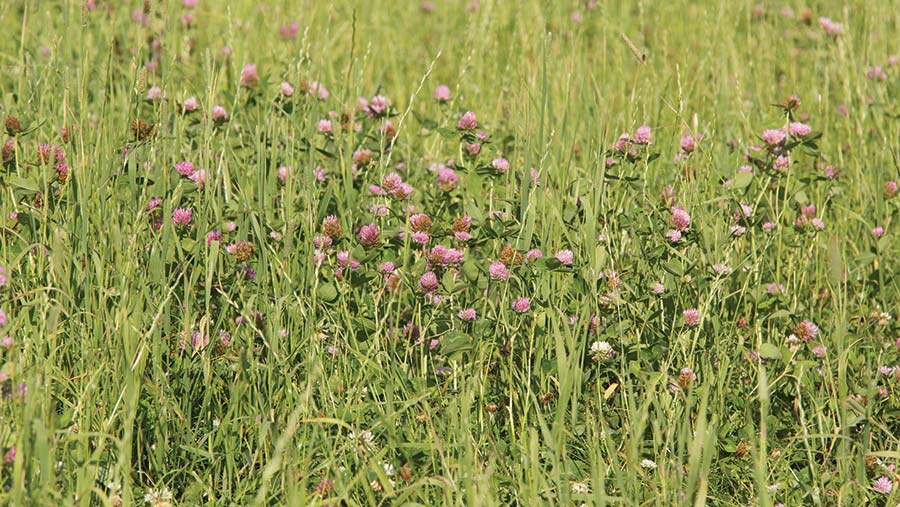Advice on establishing and growing clover in grass leys
 © Tim Scrivener
© Tim Scrivener High in protein and nitrogen fixing, clover is a great benefit on farm, but it can be a difficult species to manage.
With autumn fast approaching, it may be time to start thinking about reseeding.
With herbal leys becoming more popular, clover has proved particular favourite of farmers.
We signed into an AHDB webinar with Rod Bonshor, general manager at Oliver Seeds, to get a guide on ensuring good establishment as well as maximising the benefits for the season and duration of the ley.
What are the types of clover?
There are two types of clover: red and white.
Red clover totals 430,000 seeds/kg and has early- and late-flowering types.
White clover weighs in at 1.43m seeds/kg – there are small-, medium- and large-leaved varieties.
Why is clover beneficial?
Red clover is particularly vigorous in the spring. It is:
- High yielding – 12 to 16 t DM/ha achievable when grown with ryegrass
- High in protein
- Compatible with most grasses
- Suitable for a variety of regions and soils
- Drought resistant
- High yielding – 12t DM/ha/year over three years.
White clover has a high nutritional value and is very palatable even when it’s flowering.
- High in protein – around 27%
- Highly palatable
- Suitable for most soils except waterlogged or very acidic soil
- It’s very persistent and winter hardy so useful for summer production and improving grazing intakes.
- Large varieties are recommended for cutting, medium for dual purpose and small for grazing sheep and for building fertility
Both types are useful for nitrogen fixing and can cut down the need for fertilisers.
What should I be cautious of when sowing clover?
Red clover has low DM, ME and sugar so it can affect silage fermentation and needs a four-year rotational break.
As it has low dry matter, low water soluble carbohydrate concentrations and a high buffering capacity, it is more difficult to attain satisfactory fermentation than with all-grass silage.
It is only persistent for three years.
Red and white clover can be aggressive in mixtures, and in a dry summer can take over.
However, it’s not that persistent under hard grazing.
See also: 12 varieties added to grass and clover recommended lists
Be careful when cutting for silage because it can buffer fermentation and needs an additive.
It should be cut when the grass is dominant to help with the ensiling process.
When grazing, oestrogen levels can cause fertility issues in sheep and there is a bloat risk. To avoid bloat, there are steps you can take:
- Introduce the stock gradually to the field
- Dont turn out hungry stock
- Feed hay or straw before turnout
- Provide feed or hay in the diet (to increase fibre)
- Avoid grazing in wet or damp conditions
What grass varieties does it complement?
Generally, clovers are compatible with ryegrasses.
White clover makes a good companion crop because it can contribute more than 150kg/ha of nitrogen/year and increase total yield by 25%.
How should I sow it?
Clover prefers to be surface sown.
If you sow it too deeply, it will be very slow growing.
Choose machinery carefully as seed rates are low – 2.4-7.4kg/acre.
It may be necessary to bulk with grass seed if your machine doesn’t operate such a low seed rate.
The best options are a slug pellet applicator or a dedicated, calibrated machine followed by a ring roller to push it into the soil.
Is it a good option for permanent pasture repair?
Clovers are regularly used for pasture renovation as they can be easily introduced by surface sowing.
If it’s too dry to plough, some drills will work, so grass can be established while maintaining good soil structure.
Always allow enough time for the crop to establish before grazing.
How do I ensure it doesn’t overtake grass?
Red clover has a penetrating tap root, which can be particularly aggressive in dry conditions.
Nitrogen fertiliser can be used to accelerate grass growth and suppress clover within recommended guidelines.
Stiff tine harrowing can be used on white clover swards to break up clover stolons and reduce the overall clover population.
How do you avoid killing clover when treating weeds?
There are not many clover-safe chemicals, however effective options are still available.
An alternative is to spot spray weed patches or use a wiper for taller weeds.
What should I do if clover in pasture looks low?
If clover populations appear too low, it is relatively easy to oversow more clover seed into the sward, especially in the late summer or autumn, when grass growth slows but soil remains warm and moist.
Extra resources
- Teagasc: Red clover agronomy and management (PDF)
- See the AHDB for a comprehsive guide to establishing and growing clover
- AHDB Recommended Grass and Clover Lists 2020/21
